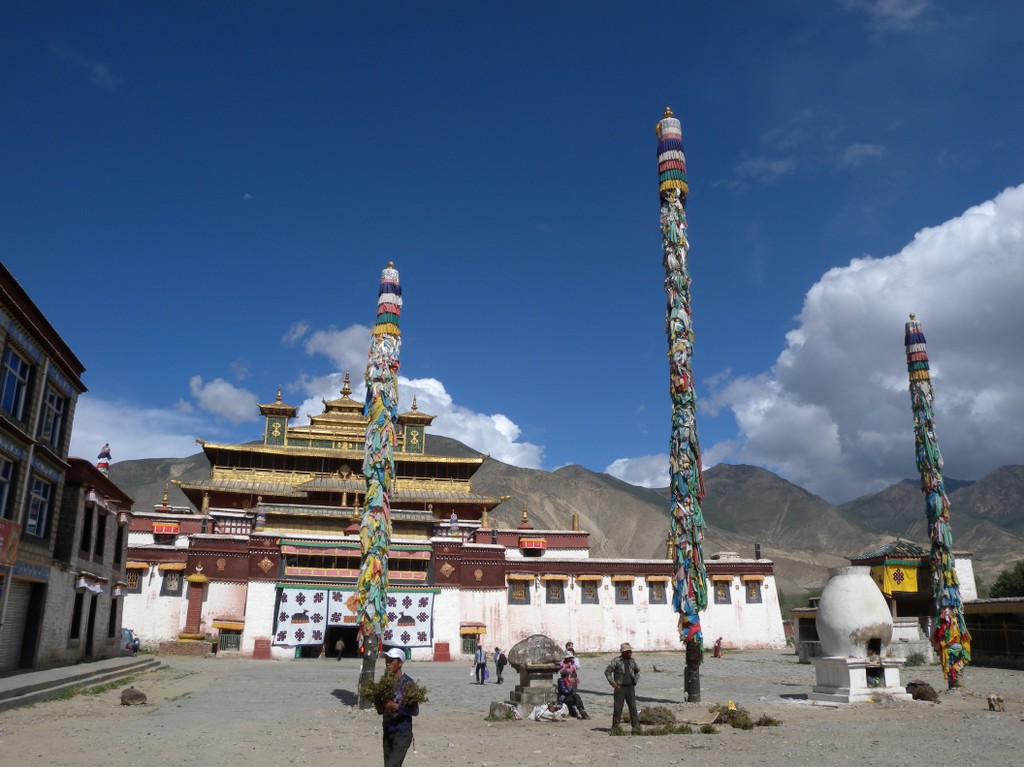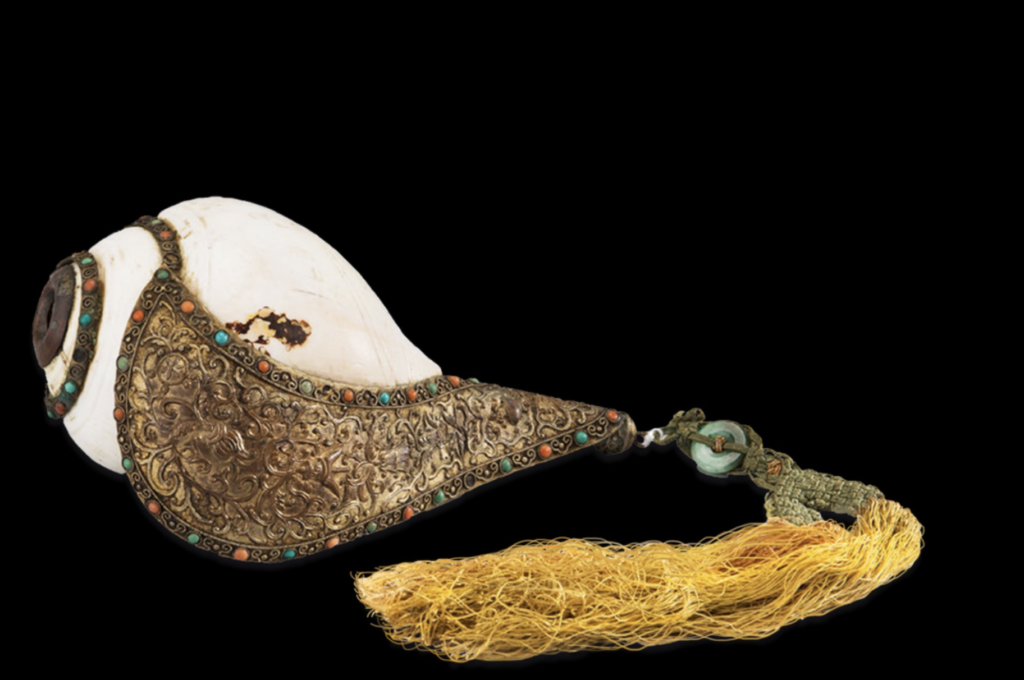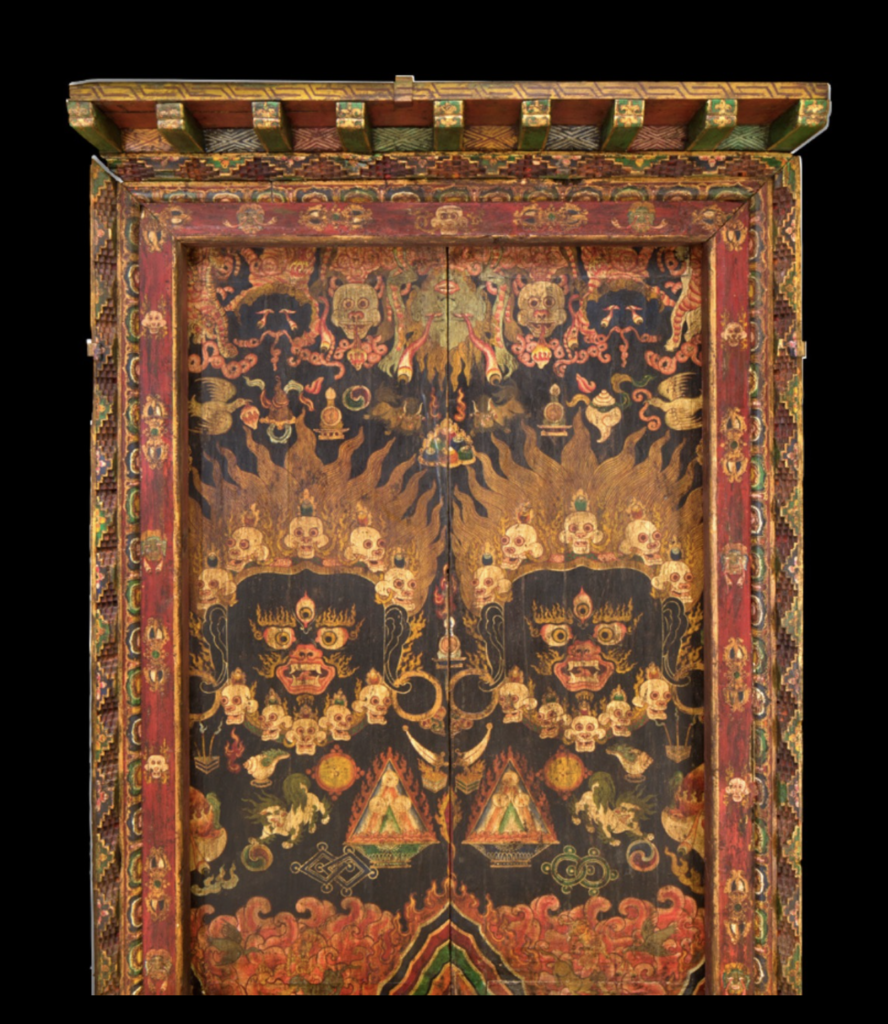Author: Ramon Carrillo Martinez
Overview
When people think of works of art, they gravitate toward paintings, sculptures, and architecture. Although these different art forms help better understand people’s identity, culture, and religion, there are more artistic expressions, such as ritual objects. In many religions and cultures, ritual objects are used for important ceremonies, each having a different purpose to fulfill. In Tibet, located in China, the primary religion practiced is Buddhism, in which people follow the laws to achieve enlightenment (nirvana). Buddhist believe that human life is one of suffering to achieve enlightenment, people must practice meditation and spiritual and physical labor. In Tibet, many monasteries serve as sacred spaces where monks spread the teachings of Buddhism to individuals that dedicate their lives to achieving enlightenment. In Tibetan monasteries, not only is a place for spreading the teaching of Buddha but there are engaging ceremonies that immerse participants in the practices of Buddhism. All of the Tibetan ceremonies use ritual objects that help gather people in a space to enhance the learning process for achieving enlightenment. By learning about Tibetan strong connection with Buddhism, I want to be able to highlight different ritual objects for Buddhism in Tibet culture and how specific design features contribute to its functionalities in ceremonies.

Goals
In this chapter, the primary focus will be analyzing Tibetan ritual objects and their purposes when it comes to participating in ceremonies. In Tibetan culture when practicing Buddhism in monasteries, over a hundred ritual objects are used to help monks understand the laws of enlightenment. There is a range of ritual objects in Tibetan culture, ranging from conch shells, decorative art, and, offering cups each holding an important component to leading the spiritual journey of the teaching of the Buddha. The following ritual objects will be highlighted: the conch shell, wrathful shrine doors, offering table, bowls, and a Buddha Shakyamuni statue. Despite the wide variety of ritual objects, the item selected in this particular order demonstrates chronically how and when people would engage with the works of art. Each item was selected for this chapter to understand the ritual ceremonies process and for people to gain insight into the power each item has when creating a form of community around the religion of Buddhism.
Conch Shell (The voice of Buddha)

As monks roam through the peaceful setting of the monastery their attention is drawn to the sound of the Conch shell that represents the voice of Buddha. The person who would blow into the shell is a monk that alerts the others of the ceremony beginning for people to participate. There are two types of snail couches one that has a right and left spiral depending on the swirl on the shell it determines how they are decorated. Many of the left spiral shells are decorated elegantly and are placed in secured areas only to be used for special ceremonies. As for the couch shell presented this one is the most commonly used due to the spiral heading towards the right. The most noticeable design features are the metal mouthpiece and three-dimensional carving plate on the side for the person using the object to have a good grasp when handling the shell. Despite this specific conch shell being commonly used it is still decorated elegantly with colored stones and floral carvings to emphasize the importance of the purpose of using the voice of Buddha to gather the monks. Once the ceremony ends the conch shell is blown one more time at the end to alert people that the ceremony has come to an end. As the monks leave the ceremony they are reminded of the sound of the conch shell that represents the voice of buddha guiding them to enlightenment.
WRATHFUL SHRINE DOORS

Once the Conch shell alerts the monks to attend the shrine rooms for the ceremony to begin they would walk through highly decorated hallways with images of Buddha and the protectors of the monastery. Images such as the Wrathful Shrine Doors highlight the first encounter of learning about the protector of the sacred space before heading inside. In Tibetan culture, each protector deities have its shrine room door dedicated to them to demonstrate the importance of the space. For each door panel the image of Mahakala, one of the most popular guardians in Tibetan Buddhist culture, is depicted to show the importance of the shrine room. Flames and skulls surround Mahakala to represent the power this guardian has to protect the monks and the teachings of Buddha from the evil that would prevent people from achieving enlightenment. There are also images of ritual objects such as the Conch shell to represent the unity that this item brings to the monastery and the vajra to showcase a powerful weapon to push out evil. Lastly, the image of the door showcases the offering of the bowels to demonstrate the purpose of the shrine room. Normally people would make offerings to the Buddha to keep him present in the monk’s journey of finding enlightenment.
OFFERING TABLE

When the monks enter the shrine room they would see works of art dedicated to the Buddha and protectors of the sacred space. In addition to all the decorative works of art, there are ritual objects placed close together for the monks to engage with to participate in the ceremonies and learn the teachings of the Buddha. One of the first ritual objects that the monks would encounter is the offering table, which is located in the center of the shrine room. On top of the table normally there would be objects such as butter lamps and bowels in which monks can make an offering to the Buddha. The offering table could be made out of two different materials such as wood and gilt copper. In this instance, the offering table presented is made out of gilt copper to represent the rareness of using the table for special ceremonies. In the front of the table, there are eight offering goddesses meaning an offer of the universe in the form of a mandala. Each of the Offering goddesses are performing almost a dancing ritual with the mandala as a part of the ceremony. Additionally, throughout the offering table, there are eight auspicious symbols that represent the spiritual path that leads to freedom from suffering and the inner peace of enlightenment. Lastly on the sides are eight different offerings that would be placed on top of the table for the Buddha. These visual images of the goddesses, auspicious symbols, and offerings demonstrate the purpose of the table used during the ceremonies to ensure to the monks that if they follow all the laws they can achieve enlightenment.
STEMMED OFFERING BOWLS

On top of the offering table, there are about seven silver bowels above the Buddha shrine. In order to make an offering they all must be kept inside the bowel in order to keep each thing offered separated due to their purpose. Each of the seven bowls is elegantly decorated with silver material on a raised stand. The offerings bowl is etched with the symbol of good fortune to signify that if a person makes an offering in the bowl then they will be gifted with good fortune. Despite the small scale and limited design features, each bowl holds significance to it such as water for drinking and washing hands, flowers for welcoming offers, rice, oil for the eyes, perfume-scented water, and food. These bowls are changed daily as an offering to the Buddha for teachings and to remain in this world The bowl also purifies the monk’s body and mind from negativity as they enter the shrine. As one sees these bowls hold significant importance to the ceremonies in the shrine it not only guides the monk on how to properly present the offering to the Buddha but it teaches them the purpose of the cups and what they should provide to purify themselves from negativity.
BUDDHA SHAKY AMUNI

Lastly, above the offering table and bowls, all of the items dedicated are to the Buddha statue located in a shrine in the center of the room. The reason why the Buddha statue is located in the center of the room is that this is where the monks use gravitate in order to place on offering in the bowl and begin the process of meditation in front of the statue. The Buddha statue presented was created in the 14th century and it is made out of gilt copper but it is colored in gold to represent the high importance of the Buddha figure as a leader to the enlightenment that every believer of Buddhism is trying to achieve. The Buddha figure wears a blue jeweled crown to highlight his past of being born with wealth and a royal family. The crown reminds people that even being born into wealth does not mean that an individual has reached enlightenment. Instead, the crown on the Buddha represents that even with all the wealth in the world there are still practices that need to be done to reach enlightenment. Although the crown on the Buddha’s head is represented on his head to remind people of his past. His robe indicates leaving a wealthy life to find the true meaning of enlightenment by meditating and ending all suffering. The Buddha is positioned sitting down with his legs crossing in a meditative position as he is meditating both his hand are in his lap area to demonstrate the proper way of meditation. Lastly, the buddha’s face is in a peaceful and relaxed state indicating that when a person has reached enlightenment they are at peace with themselves. As one can see the statue is set as a demonstration to the monks and other believers of Buddhism that no matter what background people come from they can achieve enlightenment if they follow all the laws to end suffering.
Final Thoughts
When examining Tibetan ritual objects, each of them create an experience for the monks to participate in the ceremony. As one can see each of the items are not simply just objects but they are works of art that help guide the process of enlightenment. Not only are these ritual objects used for ceremonial purposes but they are used as a teaching tool for monks to understand their functionalities. Similar to any traditional Tibetan artwork, these ritual objects are just as important to learn about to understand Buddhism. Each of the items design features help understand the ritual objects functionalities leading into the pathway to enlightenment. Unlike any traditional works Asian works of art is more about the experience in which people engage with art pieces and how they can have different functionalities whether that is through a spiritual journey or used as a learning tool to learn about Asian culture. These five ranges of ritual objects without a doubt helps people understand that Tibetan works of art are beyond the aesthetic. Instead they are used to not only educate monk but people what are interested in to learn about Buddhism and its traditions.
Bibliography
Baubonis, Alan. n.d. Samye Monastery(Sangyesi). Photograph.
Fisher, Robert E. 1997. Art of Tibet.
Gentry, James Duncan. 2016. Power Objects in Tibetan Buddhism: The Life, Writings, and Legacy of Sokdokpa Lodrö Gyeltsen. BRILL.
Henss, Michael. 2020. Buddhist Ritual Art of Tibet: A Handbook on Ceremonial Objects and Ritual Furnishings in the Tibetan Temple.
Rubin Museum of Art. n.d. “Six Inspirational Objects You’ll Find in a Tibetan Buddhist Shrine Room | Rubin Museum of Art.” https://rubinmuseum.org/blog/6-inspirational-objects-youll-find-in-a-tibetan-buddhist-shrine-room.
———. n.d. “Six Inspirational Objects You’ll Find in a Tibetan Buddhist Shrine Room | Rubin Museum of Art.” https://rubinmuseum.org/blog/6-inspirational-objects-youll-find-in-a-tibetan-buddhist-shrine-room.
Sotheby’s. 2014. “Understanding the World of Tibetan Ritual Objects.” https://www.youtube.com/watch?v=4I1pljKyfX8.
Sound Terminus. 2020. “Monk at Lenggu Monastery Blowing a Conch Shell Horn.” https://www.youtube.com/watch?v=jhX_7k-_fmc.
“Top 8 Holy Ritual Items of Tibetan Buddhism.” 2019. Tibet Travel and Tours – Tibet Vista, November. https://www.tibettravel.org/tibetan-buddhism/ritual-items-of-tibet-buddhism.html.